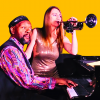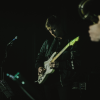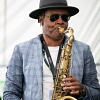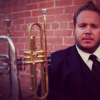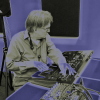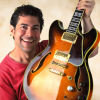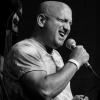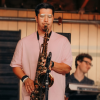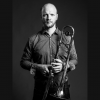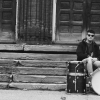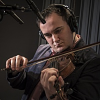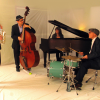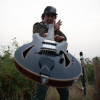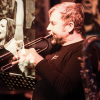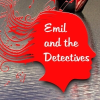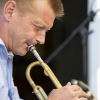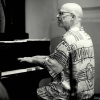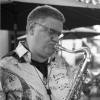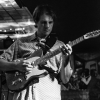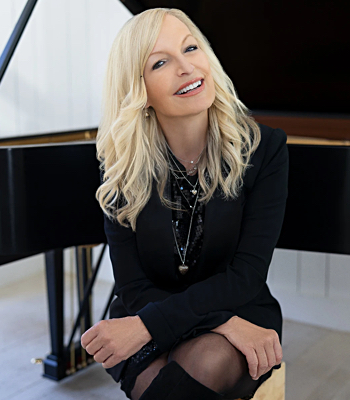Home » Jazz Musicians » Miles Davis
Miles Davis

Throughout a professional career lasting 50 years, Miles Davisplayed the trumpet in a lyrical, introspective, and melodicstyle, often employing a stemless harmon mute to make hissound more personal and intimate. But if his approach to hisinstrument was constant, his approach to jazz was dazzlinglyprotean. To examine his career is to examine the history ofjazz from the mid-'40s to the early '90s, since he was in thethick of almost every important innovation and stylisticdevelopment in the music during that period, and he often ledthe way in those changes, both with his own performancesand recordings and by choosing sidemen and collaboratorswho forged the new directions. It can even be argued that jazzstopped evolving when Davis wasn't there to push it forward.
Davis was the son of a dental surgeon, Dr. Miles DeweyDavis, Jr., and a music teacher, Cleota Mae (Henry) Davis,and thus grew up in the black middle class of East St. Louisafter the family moved there shortly after his birth. He becameinterested in music during his childhood and by the age of 12had begun taking trumpet lessons. While still in high school,he started to get jobs playing in local bars and at 16 wasplaying gigs out of town on weekends. At 17, he joined EddieRandle's Blue Devils, a territory band based in St. Louis. Heenjoyed a personal apotheosis in 1944, just after graduatingfrom high school, when he saw and was allowed to sit in withBilly Eckstine's big band, which was playing in St. Louis. Theband featured trumpeter Dizzy Gillespie and saxophonistCharlie Parker, the architects of the emerging bebop style ofjazz, which was characterized by fast, inventive soloing anddynamic rhythm variations.
It is striking that Davis fell so completely under Gillespie andParker's spell, since his own slower and less flashy stylenever really compared with theirs. But bebop was the newsound of the day, and the young trumpeter was bound tofollow it. He did so by leaving the Midwest to attend theInstitute of Musical Art in New York City (since renamedJuilliard) in September 1944. Shortly after his arrival inManhattan, he was playing in clubs with Parker, and by 1945he had abandoned his academic studies for a full-time careeras a jazz musician, initially joining Benny Carter's band andmaking his first recordings as a sideman. He played withEckstine in 1946-1947 and was a member of Parker's group in1947-1948, making his recording debut as a leader on a 1947session that featured Parker, pianist John Lewis, bassistNelson Boyd, and drummer Max Roach. This was an isolateddate, however, and Davis spent most of his time playing andrecording behind Parker. But in the summer of 1948 heorganized a nine-piece band with an unusual horn section. Inaddition to himself, it featured an alto saxophone, a baritonesaxophone, a trombone, a French horn, and a tuba. Thisnonet, employing arrangements by Gil Evans and others,played for two weeks at the Royal Roost in New York inSeptember. Earning a contract with Capitol Records, the bandwent into the studio in January 1949 for the first of threesessions which produced 12 tracks that attracted littleattention at first. The band's relaxed sound, however, affectedthe musicians who played it, among them Kai Winding, LeeKonitz, Gerry Mulligan, John Lewis, J.J. Johnson, and KennyClarke, and it had a profound influence on the development ofthe cool jazz style on the West Coast. In February 1957,Capitol finally issued the tracks together on an LP calledBirth of the Cool.
Read moreTags
Miles In France 1963 & 1964: The Bootleg Series Vol. 8

by Doug Collette
At the very same time Beatlemania was slowly but surely beginning to engulf the globe, Miles Davis was inexorably proceeding toward what was the most adventurous music of his career. Miles In France -The Bootleg Series Vol. 8 captures a group of musicians led by “The Man with the Horn" on the threshold of forming what is referred to as his second great quintet, then actually coalescing into that stellar outfit. And the drama within that designation rapidly ...
Continue ReadingOJC Trumpet Titans: Miles Davis and Clark Terry

by C. Andrew Hovan
Back in 2007 when the vinyl renaissance began gaining ground in the sales arena, few would have predicted the vast amount of product that has flooded the marketplace, from obscure reissues to the unearthing of many previously unheard gems. While under the leadership of Fantasy, the Original Jazz Classics series ended up reissuing almost a thousand titles before going dormant in the late '90s. Since dusting off the moniker in 2023, Craft Recordings has brought forth a consummate selection of ...
Continue ReadingThe Sound of the Fender Rhodes, Part 1

by Len Davis
Cannonball Adderley, Miles Davis, Joe Zawinul and Freddie Hubbard. Classics from the '70s featuring the Fender Rhodes. This show was inspired by Chris Mays' outstanding article, Ten Supreme Fender Rhodes Albums. Playlist The Cannonball Adderly Quintet “Mini Mamma" from Why Am I treated So Bad (Blue Note) 00:00 Miles Davis “Splash" from The Complete In A Silent Way Sessions (Columbia) 10:33 Miles Davis “John McLaughlin" from Bitches Brew (Columbia) 21:06 Joe Zawinul “In A Silent Way" from Zawinul ...
Continue ReadingInterview with James Kaplan

by Patrick Burnette
What's the most famous jazz album in the world? Don't say Duke Ellington Plays Mary Poppins unless you have a really good excuse, like you work for Disney. And please don't name some album by Kenny G even if that's sort of true. No, of course the most famous jazz album is Kind of Blue, and our special guest this episode wrote a book on the three geniuses who brought it into being. Please enjoy this interview with author James ...
Continue ReadingYour Favorite Legacy Jazz Trumpet Players

by Michael Ricci
Member votes were tabulated and this list represents our favorite legacy jazz trumpet players. Fully transparent and easily verifiable, All About Jazz's favorite legacy trumpet players poll was conducted during the 2023-2024 calendar year and ran up through June 26, 2024. We want to thank every member who participated in creating this impressive list for the next generation of jazz enthusiasts to discover. 1Miles Davis2Freddie Hubbard3Dizzy Gillespie4Chet Baker5Louis Armstrong6Lee Morgan7Clifford Brown8Donald Byrd9Don Cherry10Roy Hargrove11Kenny Dorham12Clark Terry13Al Hirt14Harry “Sweets" ...
Continue Reading3 Shades of Blue: Miles Davis, John Coltrane, Bill Evans And The Lost Empire Of Cool

by Carlos Tribino
3 Shades of Blue: Miles Davis, John Coltrane, Bill Evans And The Lost Empire Of Cool James Kaplan496 Pages ISBN: #9780525561002 Penguin Random House 2024 James Kaplan's 3 Shades of Blue is an intimate biographic work that takes you through a fly-on-the-wall journey on the careers of three of the greatest jazz musicians of all time: Miles Davis, John Coltrane and Bill Evans. In 1959, the three recorded what is widely considered as ...
Continue ReadingMelissa Aldana, Spike Wilner & Miles Davis

by Joe Dimino
We begin the 849th episode of Neon Jazz with Miles Davis to commemorate the book 3 Shades of Blue by James Kaplan. The book examines the phenomena of the iconic Kind of Blue album. From there, we hear Bill Evans and Jim Hall with music from Undercurrent (1962). We get a good dose of new tunes from Spike Wilner, Ken Peplowski and Danette McMahon. In between, we hear Rufus Reid and Eddie Harris. We close the show with Melissa Aldana ...
Continue ReadingMiles Davis: Miles 54, the Prestige Recordings

Source:
JazzWax by Marc Myers
In 1954, Miles Davis's future meant considerably more than his past. Recording for Prestige since 1951 (The New Sounds was his first album for the label), the trumpeter came into his own in 1954. Returning to New York in February of that year after kicking his heroin habit, Davis had also kicked his bebop fixation. What emerged was a cooler sound that came with space, a trumpet mute and a style influenced by vocalist Helen Merrill's close, breathy proximity to ...
read more
Backgrounder: Miles Davis - Miles Ahead, 1957

Source:
JazzWax by Marc Myers
Miles Davis's Miles Ahead: Miles +19 for Columbia is one of jazz's most exquisite orchestral albums. The LP was arranged by Gil Evans, who, with Davis, selected nine jazz songs plus an Evans-Davis original and dressed them up in a modernist, Thornhillian style. The result is spectacular. Davis on flugelhorn is gentle and at times even meek as Evans's orchestrations descend on him like a violet mist. It's pure musical poetry. One should note that Evans and Davis were together ...
read more
Perfection: Miles Davis - A Gal in Calico

Source:
JazzWax by Marc Myers
On June 7, 1955, Miles Davis recorded Musings of Miles for Prestige. One of the tracks for the album was “A Gal in Calico," composed by Arthur Schwartz. It was introduced in the 1946 film The Time, the Place and the Girl. Musings of Miles was the trumpeter's first 12-inch LP (earlier ones were 10 inches). The musicians were Miles Davis (tp), Red Garland (p), Oscar Pettiford (b) and Philly Joe Jones (d). Garland and Jones would go on to ...
read more
'Listen To This' Exploring The Early Electric Period Of Miles Davis

Source:
Mary Curtin Productions
For the past year, improvising keyboardist Dave Bryant, curator and host of the “Third Thursdays" series of monthly harmolodic jazz concerts, has also been involved with the “Listen To This" musical project, which explores the rich musical legacy of Miles Davis, particularly from his early electric period 1968-1975. The project includes founder Jerome Deupree of Morphine and Either/Orchestra (drums), Russ Gershon of Either/Orchestra (woodwinds, organ), Rick Barry of Bim Skala Bim and Lookie Lookie (percussion), Todd Brunel of Know Orchestra ...
read more
Jazz Musician of the Day: Miles Davis

Source:
Michael Ricci
All About Jazz is celebrating Miles Davis' birthday today!
Throughout a professional career lasting 50 years, Miles Davis played the trumpet in a lyrical, introspective, and melodic style, often employing a stemless harmon mute to make his sound more personal and intimate. But if his approach to his instrument was constant, his approach to jazz was dazzlingly protean. To examine his career is to examine the history of jazz from the mid-'40s to the early '90s, since he was in ...
read more
August 1969: Rock, Jazz and Women
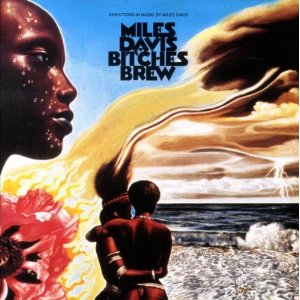
Source:
JazzWax by Marc Myers
August 1969 marked a dramatic turning point in the evolution of two forms of popular music—rock and jazz. In both cases, women came up short. The first transition took place In Bethel, N.Y., between August 15 and 18. There, four co-promoters of a four-day music festival known as Woodstock proved that rock and the rock concert were a much bigger deal than previously thought. With an estimated 400,000 people stretched out on hilly pastures running to the horizon, the audience's ...
read more
Jazz Musician of the Day: Miles Davis

Source:
Michael Ricci
All About Jazz is celebrating Miles Davis' birthday today!
Throughout a professional career lasting 50 years, Miles Davis played the trumpet in a lyrical, introspective, and melodic style, often employing a stemless harmon mute to make his sound more personal and intimate. But if his approach to his instrument was constant, his approach to jazz was dazzlingly protean. To examine his career is to examine the history of jazz from the mid-'40s to the early '90s, since he was in ...
read more
Jazz Musician of the Day: Miles Davis

Source:
Michael Ricci
All About Jazz is celebrating Miles Davis' birthday today!
Throughout a professional career lasting 50 years, Miles Davis played the trumpet in a lyrical, introspective, and melodic style, often employing a stemless harmon mute to make his sound more personal and intimate. But if his approach to his instrument was constant, his approach to jazz was dazzlingly protean. To examine his career is to examine the history of jazz from the mid-'40s to the early '90s, since he was in ...
read more
Miles: Ascenseur pour l'échafaud

Source:
JazzWax by Marc Myers
Known in English as Elevator to the Gallows, this 1958 French crime film is notable for three reasons: The movie, directed by Louis Malle, launched French new wave cinema. It stars Jeanne Moreau, one of France's finest actresses and a personal favorite. And best of all, Miles Davis improvises throughout. In a nutshell, the film is about two lovers who become involved in a murder plot and are foiled when an elevator's power is cut. The rest is too complicated ...
read more
Jazz Musician of the Day: Miles Davis

Source:
Michael Ricci
All About Jazz is celebrating Miles Davis' birthday today!
Throughout a professional career lasting 50 years, Miles Davis played the trumpet in a lyrical, introspective, and melodic style, often employing a stemless harmon mute to make his sound more personal and intimate. But if his approach to his instrument was constant, his approach to jazz was dazzlingly protean. To examine his career is to examine the history of jazz from the mid-'40s to the early '90s, since he was in ...
read more



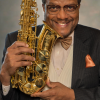







.jpg)

.jpg)












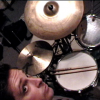

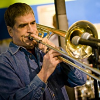



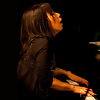








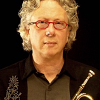












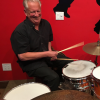



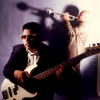








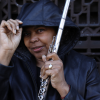






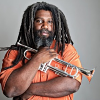
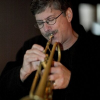







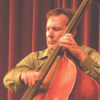



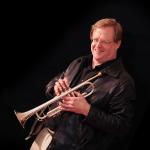



















































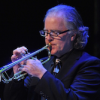







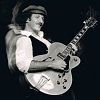












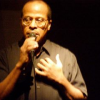









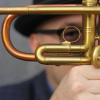























.jpg)














